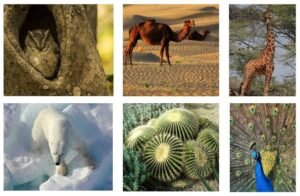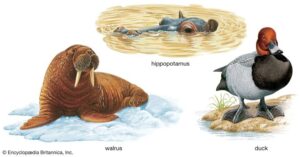Back to: ZOOLOGY 200 Level
WELCOME TO CLASS
It’s time to uncover how animals and plants adapt to their environments and the vital roles they play in ecosystems. Today’s topic—Adaptations and Ecological Roles—will show you how different species survive, thrive, and contribute to the balance of nature. Let’s get started!
Adaptations And Ecological Roles
What are adaptations?
Adaptations are special features or behaviours that help an organism survive in its environment. These adaptations can be structural (physical features), behavioural (patterns of activity), or physiological (internal processes). Whether it’s a thick coat to survive the cold, or sharp claws for catching prey, adaptations ensure that an organism can meet its needs and reproduce in its habitat.

Types of adaptations
There are three main types of adaptations:
Structural adaptations are physical changes that help an organism survive. For example, camels have wide, flat feet that help them walk on hot sand, while cactus plants have thick, waxy skins that prevent water loss in the desert.
Behavioural adaptations involve changes in how an organism behaves. Birds, for instance, migrate long distances to avoid cold winters, while predators like lions hunt in packs to increase their chances of capturing prey.
Physiological adaptations are changes in an organism’s internal processes. For example, fish living in deep, dark oceans can produce their own light through a process called bioluminescence. Similarly, some animals, like frogs, can enter a state of dormancy during dry seasons to conserve energy and water.
Ecological roles
Every organism plays an important role in its ecosystem. The way animals interact with other species and their environment is key to maintaining balance. Here are some of the main ecological roles:
Producers – These are usually plants or algae that produce energy through photosynthesis. They form the base of food chains.
Consumers – These organisms consume other organisms for food. Herbivores eat plants, carnivores eat other animals, and omnivores eat both plants and animals.
Decomposers – These organisms break down dead plants, animals, and waste, recycling nutrients back into the environment. Examples include fungi, bacteria, and some insects like millipedes.
Pollinators – Certain animals, especially insects like bees, butterflies, and bats, transfer pollen from flower to flower, aiding in plant reproduction.

Adaptations to different ecosystems
Different ecosystems require different adaptations. For example, in the savannah, animals like the cheetah have evolved to run fast to catch prey, while the giraffe’s long neck allows it to reach high branches for feeding. In marine ecosystems, sea creatures such as fish and dolphins have streamlined bodies that help them move efficiently through water.
In the rainforest, animals like monkeys have developed prehensile tails to help them climb trees, while birds like toucans have large, colourful beaks to help them reach fruits high up in the trees.
Summary
- Adaptations are features that help organisms survive in their environments.
- Adaptations can be structural, behavioural, or physiological.
- Organisms play various ecological roles such as producers, consumers, decomposers, and pollinators.
- Each ecosystem requires unique adaptations for survival, such as fast movement in the savannah or a streamlined body in the ocean.
Evaluation
- What are the three types of adaptations?
- Describe the ecological role of a decomposer in an ecosystem.
- How do animals in the savannah adapt to their environment?
- Explain the difference between a producer and a consumer in an ecosystem.
You’ve done a fantastic job understanding the critical role adaptations play in the survival of organisms. Keep up the great work, and remember, nature’s creativity in solving problems is limitless! We’re excited for the next lesson with you. Keep that curiosity alive, and let’s go forward together with Afrilearn!
